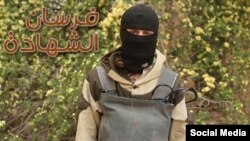"They phoned us saying they feel fine and have not seen the war yet," Shairat Kushtanashvili, the grandmother of one of two Georgian schoolboys who have gone to Syria to fight alongside the Islamic State (IS) militant group, told Georgia's InterpressNews on April 13.
The two boys -- Muslim Kushtanashvili, 16, and his 18-year-old friend Ramzan Bagakashvili are Kists -- ethnic Chechens from Georgia's Pankisi Gorge. They were last seen in Pankisi on April 2, and their disappearance has provoked anger and concern among residents of the gorge, who are asking how the two teenagers managed to pass border control and wondering who recruited them in the first place.
Kushtanashvili and Bagakashvili are not the first young men from Pankisi to travel to Syria to join the ranks of the militants. While the exact number of Pankisi Kists who have gone to Syria is not known, local residents said last year that some 50 or 60 people had traveled from Pankisi to fight alongside the militants. There are also reports that as many as 10 Georgian Muslims from the Autonomous Republic of Ajara are fighting in Syria.
Khaso Khangoshvili of the Pankisi Gorge's Council of Elders told RFE/RL's Echo of the Caucasus on April 10 -- before the two boys contacted their parents to say they had managed to join up with IS in Syria -- that the two teenagers had traveled first to Turkey, having successfully managed to pass through Georgia's border controls at the airport.
Khangoshvili questioned remarks by the Georgian Interior Ministry that the teenagers had been able to "slip past" the border guard -- even though Kists sometimes face problems crossing the border -- because they did not look like minors.
"If a person is traveling to Turkey or Azerbaijan, and Azerbaijan is also a transit country [for Syria], then such a person should be checked.... But I do not consider as serious this talk of how [the teenagers] supposedly 'slipped past' [the border guard]. How can a 16-year-old child just 'slip past' at an airport where such thorough checks are being carried out, at a time when terrorism is flaring up around the world?" Khangoshvili asked.
Khangoshvili suggested that among the border guards were those who "would let anyone through for money."
"But just think about it -- we are talking about a 16-year-old schoolboy who, I am sure, has never been to Tbilisi before. And moreover he had no experience of crossing borders," Khangoshvili told Echo of the Caucasus.
'Organized System Of Recruitment'
Khangoshvili believes that an "organization with a well-functioning system" was responsible for recruiting youth in Pankisi to fight in Syria.
The Council of Elders member said that while it was not possible to say exactly how many people from Pankisi are fighting in Syria, "someone put the figure at 50, someone else talks about 100."
"In any case a lot of them are there. There are also people from Pankisi among the warlords, apparently they are establishing certain channels with their homeland. I know that already 10 of our people have been killed there. Ten young men...." Khangoshvili said.
Michael Hikari Cecire, a Black Sea and Eurasia regional analyst and an associate scholar at the Foreign Policy Research Institute, says he has tracked a total of 12 individuals from Pankisi who have been killed fighting alongside militants in Syria, out of a total of 23 militants from Pankisi who he has identified as having joined militant groups there.
Georgian political scientist Mamuka Arishedze says that it is the Pankisi Gorge's "famous" militants in Syria -- most notably IS military commander for Syria Umar al-Shishani, also known as Tarkhan Batirashvili -- who are attracting young Kists to join the militants.
Arishedze told Georgian daily Rezonansi on April 8 that IS and Batirashvili "do not need representatives in the Pankisi Gorge." Batirashvili "is a legendary figure for the region and his one phone call is enough for the entire gorge to talk about what he said the next day," Arishedze said, referring to news reports that Batirashvili had made a single -- yet widely reported -- telephone call to his father last year.
"Even without him, there are enough propagandists who create the appropriate background. Local people participate in that activity. Their names are known to Pankisi residents, me included," Arishedze added.
Those "propagandists" are proponents of a particular brand of Islam, according to Arishedze. "We call them Wahhabis [a term used in a derogatory manner in the former Soviet Union to refer to a particular type of radical Islam]. They call themselves Salafist," he said.
Some of the proponents of this brand of Islam are bringing money into the Pankisi Gorge as humanitarian aid, Arishedze claimed.
In order to solve the problem of radicalization in Pankisi, a comprehensive approach is needed that involves "all the agencies that have direct contact with young people," Arishedze believes. "That is, the ministries of Health, Sport, and Education. They need to develop a comprehensive approach. It's not just about Pankisi but also about the Kvemo Kartli [a region in southeastern Georgia with a high population of ethnic Azeris] and Ajara," Arishedze said.
Meanwhile, the fate of Kushtanashvili and Bagakashvili, the two Pankisi teens who have just reached Syria, does not look good. The boys are "passing training" in an IS training camp, according to their grandmother, Shairat Kushtanashvili.
What awaits them after training is almost certainly fighting on a battlefield, or recruitment as suicide bombers.
A young ethnic Chechen militant, identified only as Bilyal al-Shishani, blew himself up in a suicide truck bombing this week near Tel Tamer in Syria's Hasaka Province, where IS militants are fighting the Kurdish People's Protection Units (YPG) militia. A photograph of Bilyal, shared by his fellow militants, shows a smiling young man clutching a gun. In a second photo taken by IS shortly before his suicide truck bombing, Bilyal is wearing a black balaclava.
Bilyal fought alongside the Chechen IS faction Katibat al-Aqsa which is close to the Pankisi Gorge's most famous, or infamous, militant, Umar al-Shishani/ Tarkhan Batirashvili.
Whether Batirashvili's fame prompted Bilyal to join IS or to blow himself up is unknown. But it is likely that Bilyal trained in the same IS camp in which his fellow ethnic Chechens, 16-year-old Kushtanashvili and 18-year-old Bagakashvili, are thought to be right now.
-- Joanna Paraszczuk





